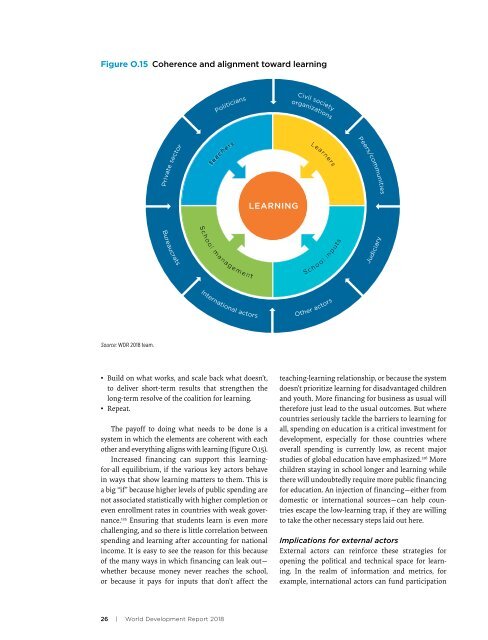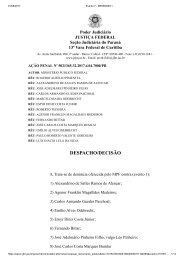Brasil só deve dominar Leitura em 260 anos, aponta estudo do Banco Mundial Relatorio Banco Mundial _Learning
You also want an ePaper? Increase the reach of your titles
YUMPU automatically turns print PDFs into web optimized ePapers that Google loves.
FIGURE O.15 Coherence and alignment towards learning<br />
Figure O.15 Coherence and alignment toward learning<br />
Politicians<br />
Civil society<br />
Civil Society Orgs.<br />
organizations<br />
Peers/communities<br />
Private sector<br />
Teachers<br />
Learners<br />
LEARNING<br />
School manag<strong>em</strong>ent<br />
Bureaucrats<br />
School<br />
inputs<br />
Judiciary<br />
International actors<br />
Other actors<br />
Source: WDR 2018 team.<br />
• Build on what works, and scale back what <strong>do</strong>esn’t,<br />
to deliver short-term results that strengthen the<br />
long-term resolve of the coalition for learning.<br />
• Repeat.<br />
The payoff to <strong>do</strong>ing what needs to be <strong>do</strong>ne is a<br />
syst<strong>em</strong> in which the el<strong>em</strong>ents are coherent with each<br />
other and everything aligns with learning (figure O.15).<br />
Increased financing can support this learningfor-all<br />
equilibrium, if the various key actors behave<br />
in ways that show learning matters to th<strong>em</strong>. This is<br />
a big “if” because higher levels of public spending are<br />
not associated statistically with higher completion or<br />
even enrollment rates in countries with weak governance.<br />
125 Ensuring that students learn is even more<br />
challenging, and so there is little correlation between<br />
spending and learning after accounting for national<br />
income. It is easy to see the reason for this because<br />
of the many ways in which financing can leak out—<br />
whether because money never reaches the school,<br />
or because it pays for inputs that <strong>do</strong>n’t affect the<br />
teaching-learning relationship, or because the syst<strong>em</strong><br />
<strong>do</strong>esn’t prioritize learning for disadvantaged children<br />
and youth. More financing for business as usual will<br />
therefore just lead to the usual outcomes. But where<br />
countries seriously tackle the barriers to learning for<br />
all, spending on education is a critical investment for<br />
<strong>deve</strong>lopment, especially for those countries where<br />
overall spending is currently low, as recent major<br />
studies of global education have <strong>em</strong>phasized. 126 More<br />
children staying in school longer and learning while<br />
there will un<strong>do</strong>ubtedly require more public financing<br />
for education. An injection of financing—either from<br />
<strong>do</strong>mestic or international sources—can help countries<br />
escape the low-learning trap, if they are willing<br />
to take the other necessary steps laid out here.<br />
Implications for external actors<br />
External actors can reinforce these strategies for<br />
opening the political and technical space for learning.<br />
In the realm of information and metrics, for<br />
example, international actors can fund participation<br />
26 | World Development Report 2018








